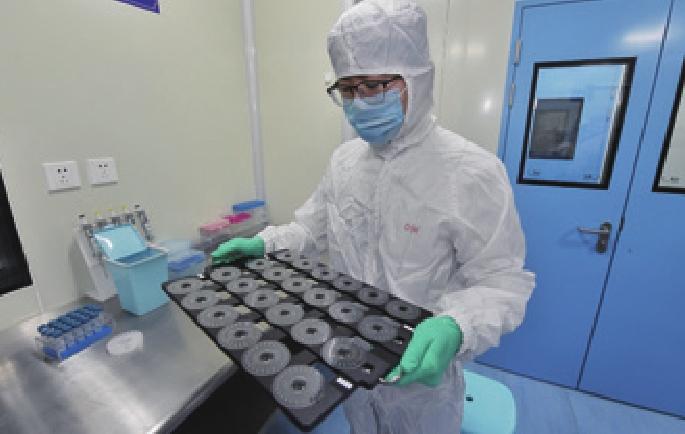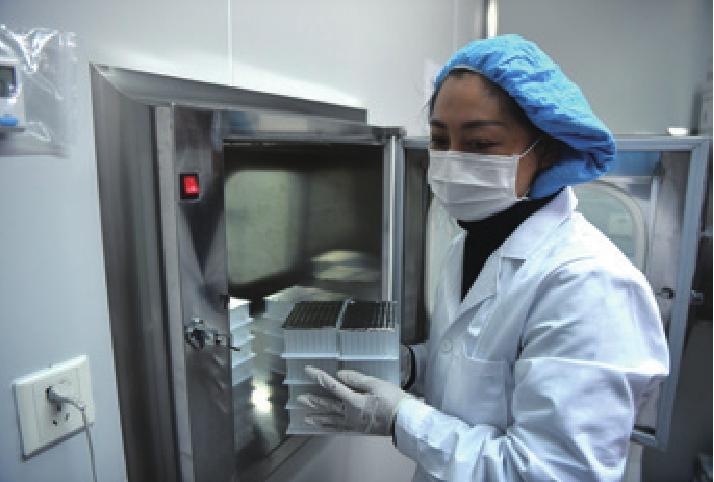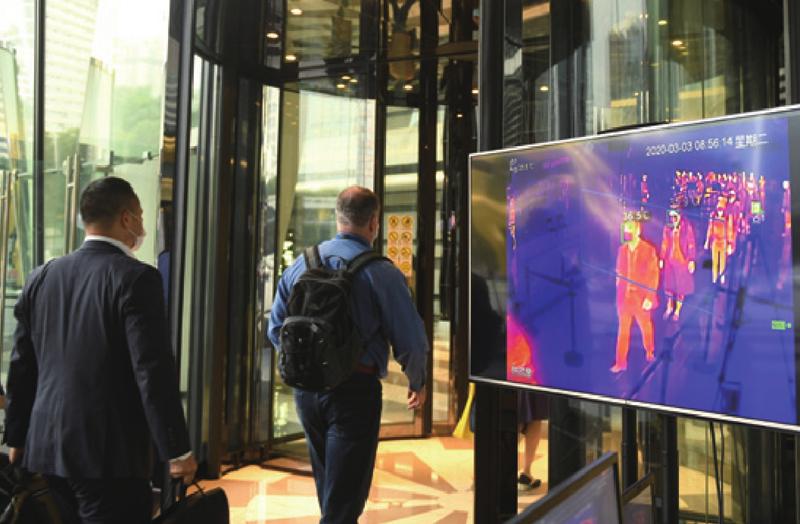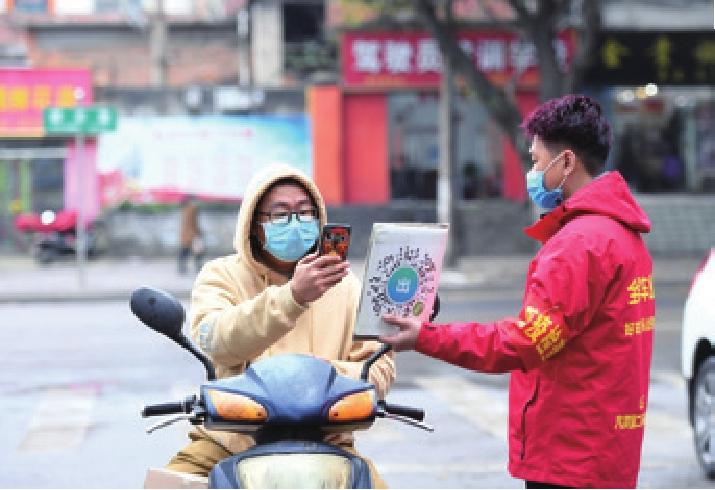When Life Becomes Sci-Fi
By Ma Miaomiao & Li Nan



Yi Jinyu, a community worker in Yichun in Jiangxi Province, east China, has gained magic wings to help him combat the novel coronavirus epidemic.
He and his colleagues had to visit local residents door-to-door every day to record their temperatures, as communities and villages are an important battleground to fight the epidemic, but residents worried such visits could cause cross-infection.
So the community turned to technology to allay the fear. They began to use a drone whose infrared thermal imaging lens can take temperatures, and now the innovation works fine, Yi told Xinhua News Agency.
The drone also has a loudspeaker. When it comes near a residence, the loudspeaker blares out an announcement and people come to their windows to have their temperature taken. This ingenious practice has ended the need for close contact between community workers and residents and reduced the risk of infection.
Drones are used in many cities to carry out increasingly more diversified epidemic prevention and control tasks, such as broadcasting messages about how to take protective measures and spray disinfectants in public spaces.
“Science and technology are the most powerful weapon in humanitys battle against diseases,” President Xi Jinping said during his visit to the Academy of Military Medical Sciences and the School of Medicine at Tsinghua University in Beijing on March 2, when he urged advancing coordinated scientific research to combat the disease.
“Mankind cannot defeat a major disaster or epidemic without scientific development and technological innovation,” he said. While the progress made by science and technology experts in just over a month has provided strong support to the epidemic prevention and control, more efforts are needed to seek solutions through science, he added.
Frontline assistants
Xi has called for accelerating the development of new types of test kits, antibody medicines, vaccines and diagnosis and treatment plans.
Chinese scientists are working to develop several types of vaccines for the novel coronavirus disease (COVID-19) simultaneously, Zhang Xinmin, Director of the China National Center for Biotechnology Development under the Ministry of Science and Technology, said at a press conference on February 15. Some of these are already being tested on animals.
At the Tongji Medical College under the Huazhong University of Science and Technology in Wuhan in central China, the epicenter of the outbreak, research on the diagnosis and treatment of the disease has been intensified. Antibody test kits have been developed to detect the virus. Antibodies are proteins produced in the blood to fight an alien body like a virus or bacteria that enters it.
Before the kit was developed, nucleic acid tests were the most commonly used tests. But the antibody test kits deliver results faster, are easier to operate and cost less, said Chen Jianguo, dean of the college.
The college is also researching and developing drugs for COVID-19, including traditional Chinese medicine drugs, with some already under clinical trial, he added.
Besides scientists and researchers, Chinese tech giants are also providing support. Baidu has given genetic researchers access to its RNA prediction algorithm. The tool can halve the time taken to predict the RNA secondary structure of the virus under study, which would speed up the development of medical therapies.
In February, a hospital in Zhengzhou, capital of Henan Province in central China, began to use scan machines with a sophisticated artificial intelligence (AI)-based system developed by Damo Academy, the scientific research arm of the Alibaba Group. It can analyze CT images of COVID-19 patients in 20 seconds with 96 percent accuracy, the developer said.
The West China Hospital of Sichuan University, one of Chinas famous hospitals, has adopted 5G technology to conduct CT scans and diagnose patients remotely. On March 2, doctors in Sichuan Province in the southwest remotely diagnosed 106 people in Huanggang, a city in Hubei, the province where Wuhan is located.
“With 5G technology, we are able to control the CT scanners in distant hospitals on a real-time basis,” Li Zhenlin, Deputy Director of the Radiology Department in the Sichuan hospital, told CGTN. The scans are highly effective in diagnosing patients who display no obvious outward symptoms, enabling patients to be identified and treated at an early stage and preventing further spread of the epidemic, Li said. However, he added that CT scans play a supplementary role and should be done alongside nucleic acid testing.
Information sharing
New technologies, including AI and big data, have been applied to epidemiological investigation to trace where the virus came from and how it has developed.
Digital maps supported by big data are helping to monitor population flows and trends as people gradually return to their cities of residence and resume work. Baidu tracks the population flow data of 300 cities every day, and its map application can show where passengers come from and go and the population migration scale, trend and intensity. The information can be used for scientific research, by the government, the media and even the public.
Another leading Chinese navigation service provider, AutoNavi, has launched an online application for the public to check passenger flow on Beijings subways, according to Beijing Daily.


In February, the Ministry of Civil Affairs urged tech giants to develop software that would help contain the spread of the novel coronavirus in residential communities. Soon after that, Hangzhou in east China became the first city in the country to adopt a health QR code system.
Residents report their health condition via government service applications or thirdparty platforms. The system then assigns them a QR code in one of three colors: red, yellow or green according to their health condition and travel history. Those who are in good health will be given a green code and can return to work and move around the city freely. Yellow and red code holders must stay in quarantine for a number of days. During this period, they need to log into the system every day till their codes turn green.
More cities have now assigned residents such QR codes. Tencent has also announced a similar system developed in collaboration with a division of the National Development and Reform Commission.
A national health code system was launched on February 29. It will gradually be connected with local systems.
Yu Jianxing, Dean of the School of Public Affairs of Zhejiang University, said the health QR code is a precise and smart way to prevent and control epidemic. “Its also a very important technical tool to facilitate the resumption of work and production,” he said.
At the same time, the Ministry of Industry and Information Technology is ensuring that residents data collected through the health code system is only used for epidemic prevention and control. In Beijing for example, all such data is kept by the Beijing Municipal Government, used only for epidemic prevention and control, and deleted regularly. Privacy is ensured, said Pan Feng, an official with the Beijing Municipal Bureau of Economy and Information Technology, on March 1.


Futuristic technologies
In Chunxi Road, a shopping street in Chengdu, capital of Sichuan, epidemic fighters taking peoples temperature wore helmets reminiscent of science fiction. The smart helmets featured an infrared temperature detector, a camera that can read QR codes, and a processor to analyze, store and upload the information it obtained onto an official network.
The outbreak has created more sci-fi scenes. E-commerce company JD.com has been using robots to carry packages from delivery vehicles to recipients in Wuhan. They serve both hospitals treating COVID-19 patients and residents who buy things online while staying at home.
Robots are also used to spray disinfectants in public spaces. A Shanghai-based medical robot developer, TMiRob, has sent 30 disinfection robots to major hospitals in Wuhan for use in quarantine wards, intensive care units, operating rooms and fever clinics. They provide around-the-clock disinfection service in quarantined zones, dispensing with the need for human intervention, China Daily reported.
As more enterprises resume work, disinfection in offices and factories can also be undertaken by robots. Youibot, another Chinese robot maker, has signed a contract with a manufacturer in Suzhou in Jiangsu Province, east China, to disinfect its plant. In addition, 35 of its robots will be on duty in Shenzhen, an industrial hub in Guangdong Province in south China.

